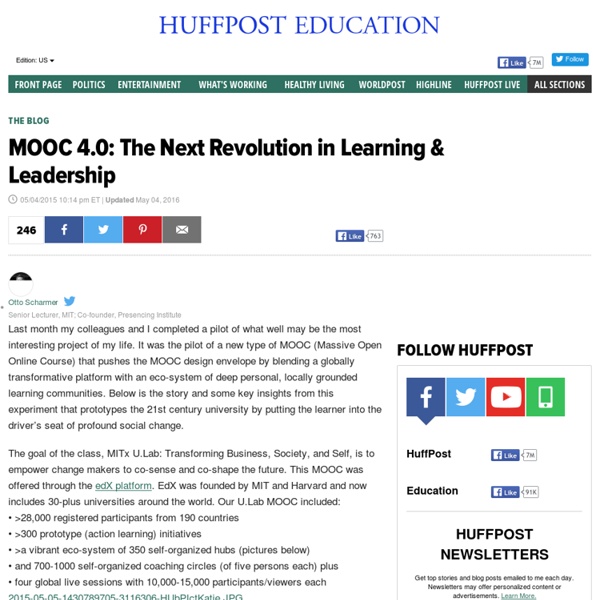MOOC 4.0: The Next Revolution in Learning and Leadership

La Finlande veut abandonner les matières à l'école au profit des «sujets»
La Finlande se prépare à amorcer un changement radical de l'organisation de son enseignement, nous apprend The Independent. Le pays, qui fait partie des mieux notés au classement international Pisa, compte en effet «s'engager dans un des programmes de réforme de l'éducation les plus radicaux jamais mis en place par un Etat-nation, l'abandon du traditionnel "enseignement par matière" pour "l'enseignement par sujet"», dont le quotidien donne plusieurs exemples: «Un adolescent suivant un cursus professionnel pourra prendre des cours de "services de restauration", qui incluraient des éléments de mathématiques, de langues étrangères (pour pouvoir servir des clients étrangers), de compétences écrites et orales. Cette réforme est actuellement testée, à raison d'une ou plusieurs périodes de cours par an, dans les écoles finlandaises, notamment à Helsinki. Partagez cet article 0 likes 0 tweets 0 +1 0 linkedin Les autres vidéos Parents et Enfants
plus.google
Voici 12 Objets Connectés pour l'Education et l'Enseignement
Les objets connectés sont en train de métamorphoser l’éducation des enfants en transformant la manière et les sources d’enseignement pour aboutir à un apprentissage totalement différent. Les objets connectés ont rapidement conquis tous les secteurs d’activité. De l’agriculture à la grande distribution, les accessoires intelligents utilisent l’accès à internet pour produire et récupérer des données. Leur analyse à large échelle permet d’anticiper, de programmer et de définir des comportements adaptés, tirés de nombreuses données agrégées. Si les objets connectés font des miracles dans l’agriculture par exemple, ils vont peut être aussi révolutionner la manière dont nos enfants apprennent. Voici une présentation réalisée avec Bunkr qui rassemble 15 objets connectés qui transforment la manière dont nos enfants apprendront demain : 1- Tiggly Tiggly est un éditeur d’applications mobiles pour iPad, qui interagissent avec des formes, des lettres et des objets au contact de l’écran. 2- Make Wonder
Startups - #rmsconf : #rmsconf
Votez pour vos startups préférées en cliquant sur le symbole ♥. Les startups sont classées - de haut en bas - selon le nombre de ♥ qu'elles reçoivent. Attention : vos votes en ligne influent sur la visibilité de vos startups préférées mais pas sur leur sélection en demi-finale. C'est aux 10 parrains/marraines que reviendra la délicate mission de choisir les 10 demi-finalistes. Piste On Jobs Piste On Jobs est le premier réseau social d'entraide de recherche d'emploi par recommandation. Le site propose un nouveau système de recherche d'emploi collaboratif ainsi que différents types d'offres d'emploi. Skillsolutions software Skillsolutions Software est le premier éditeur de logiciel SIRH « gamifié ».
The History of KnowledgeWorks | KnowledgeWorks | College and Career Readiness
Since our founding in 2000, KnowledgeWorks has evolved first from an involved philanthropy focused exclusively in Ohio to become an operating foundation and finally a social enterprise engaged in work across the United States. We think about our history in three periods, each marked by its own organizational approach and program emphasis. Ensuring Access (2000-2003) We knew that even the best educational system is limited in its impact if it doesn’t reach large numbers of students. We also focused on low-wage workers and other adults who could use education as a springboard to better jobs. We fostered community involvement in the planning of new school facilities to ensure that designs for new buildings would use the best research and apply community priorities to all decisions. Creating Better Schools (2004-2008) Access is critical. These efforts touched 50,000 students and trained more than 2,000 teachers in Ohio’s urban school districts. College and Career Readiness (2009 - )
CSIS | Executive Program in Social Impact Strategy
Q: Who should apply for this program? Anyone who is serious about making a greater social impact in their work should apply. We are looking for social entrepreneurs, business and non-profit leaders, and emerging professionals who want the skills and training to do their work more effectively. Q: When should I apply? Complete your applications as soon as possible. Q: How much does the program cost? The program costs $4,950. Q: Do you offer financial aid? Our priority is to offer a quality program at the lowest price possible. Q: Do I need work experience to get accepted? Finalists are selected based on their relevant work experience, commitment to social impact and a serious desire to learn with a community of action-oriented leaders. Q: What educational background do I need to get accepted? There are no educational prerequisites to apply for this program. Q: How does this program differ from other Social Impact training programs?
Related:
Related:



